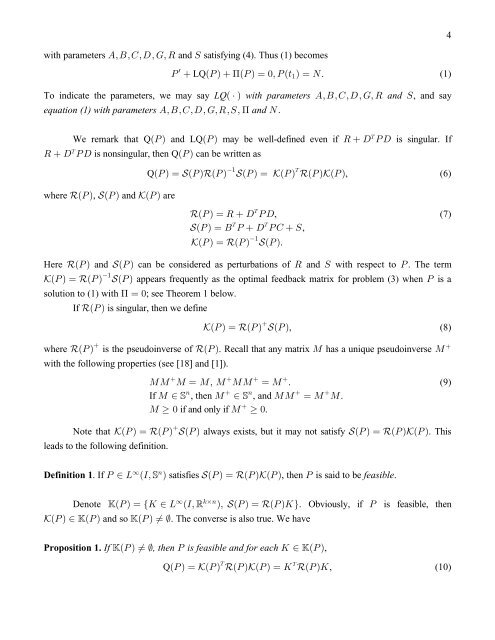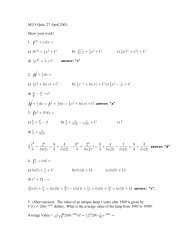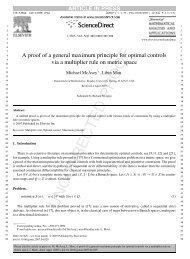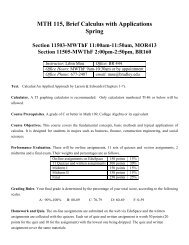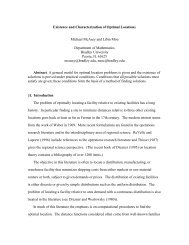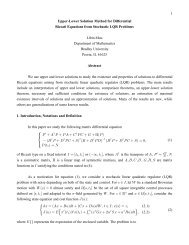1 Upper-Lower Solution Method for Differential Riccati Equations ...
1 Upper-Lower Solution Method for Differential Riccati Equations ...
1 Upper-Lower Solution Method for Differential Riccati Equations ...
Create successful ePaper yourself
Turn your PDF publications into a flip-book with our unique Google optimized e-Paper software.
4<br />
with parameters EßFßGßHßK ßV and W satisfying (4). Thus (1) becomes<br />
To indicate the parameters, we may say<br />
equation (1) with parameters EßFßGßHßKßVßWßC and RÞ<br />
w<br />
T € L Q aT b€ C aTb œ!ßTa> b œ R.<br />
(1)<br />
"<br />
LQ a† b with parameters EßFßGßHßK ßV and W, and<br />
say<br />
X<br />
We remark that Q aTb and LQ aTb<br />
may be well-defined even if V€HTH is singular. If<br />
V€HTH<br />
X is nonsingular, then Q aTb<br />
can be written as<br />
where eaTb, faT b and ^aTb<br />
are<br />
" X<br />
Q aTb œ faTbeaTb faTb<br />
œ ^aTb eaTb^aTb, (6)<br />
X<br />
eaT<br />
b œV€HTH, (7)<br />
X<br />
X<br />
faTb<br />
œ F T€HTG€W,<br />
^aTb œ eaTb faTb.<br />
Here eaT b and faTb<br />
can be considered as perturbations of V and W with respect to T. The term<br />
"<br />
^aTb œ eaTb faTb<br />
appears frequently as the optimal feedback matrix <strong>for</strong> problem (3) when T is a<br />
solution to (1) with<br />
C œ! ; see Theorem 1 below.<br />
If eaT<br />
b is singular, then we define<br />
"<br />
€<br />
^aTb œ eaTb faTb, (8)<br />
€ €<br />
where eaTb is the pseudoinverse of eaTb. Recall that any matrix Q has a unique pseudoinverse Q<br />
with the following properties (see [18] and [1]).<br />
€ € € €<br />
QQ QœQßQ QQ œQ . (9)<br />
8 € 8 € €<br />
If Q ’ , then Q ’ , and QQ œQ Q.<br />
€<br />
Q ! if and only if Q !.<br />
€<br />
Note that ^aTb œ eaTb faTb always exists, but it may not satisfy faTb œ eaTb^aTb. This<br />
leads to the following definition.<br />
Definition 1. If T P<br />
_ aMß’ 8 b satisfies f a T b œ e a T b ^ a T b , then T is said to be feasible .<br />
_ 5‚8<br />
Denote ŠaTb œ eO P aMß‘ bß faTb œ eaTbOf.<br />
Obviously, if T is feasible, then<br />
^aT b ŠaTb and so ŠaTb<br />
Ág. The converse is also true. We have<br />
Proposition 1. If ŠaTb Ág, then T is feasible and <strong>for</strong> each O ŠaTb,<br />
X<br />
X<br />
Q aTb<br />
œ ^aTb eaTb^aTb œO eaTbO,<br />
(10)


